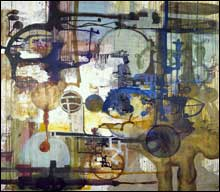 The technique of the artist isn’t usually the first thing that comes to mind when you see a work — at least not a successful one. But “Webs, Loops, and Skeins in Modern and Contemporary Art,” an exhibition at the RISD Museum of Art (through April 23), is a fascinating examination of how artists’ decisions guide and limit or open up what they create.
The technique of the artist isn’t usually the first thing that comes to mind when you see a work — at least not a successful one. But “Webs, Loops, and Skeins in Modern and Contemporary Art,” an exhibition at the RISD Museum of Art (through April 23), is a fascinating examination of how artists’ decisions guide and limit or open up what they create.
Drawn from the museum’s permanent collection, these three dozen paintings, prints, drawings, and sculptures present a broad array of related variations.
The title of the show is appropriate at a design school established to service the Rhode Island textile industry, but the correlation with approaches in art is hardly arbitrary. From the looping gestural tangles of abstract expressionists to warp and woof grid variations, we are reminded that the artistic spectrum — from loose spontaneity to strict formalism — transcends the medium employed, whether carpet threads or oil paints.
A delightful drawing by Laura Owens unites the geometrically formal with the free-flowing like a referee making two fighters shake hands. Sky blue swaths of paint establish a plaid pattern — but loosely, freehand. Behind that grid work, as though peered at through a fence, are pencil drawings of tall, stemmy flowers. Uniting the natural with the superimposed geometry is a scattering of tiny red loops of paint, squeezed straight out of the tube — whimsical and refreshing. Several styles of contemporary art, historically at loggerheads, are playing happily together.
Another work that reconciles the formal with the personal is the drawing Continuum #12 (1995), by Jacqueline Ott. It’s a vast gridwork of small boxes containing looping pencil marks interrupted abruptly at the edges of each box. Childhood recollections of being criticized for coloring outside the lines, anyone? The tension between the graceful swirling and the forbidden borders is almost poignant.
Sometimes art looks like a tangled skein of yarn not yet fashioned into a sweater, until you look carefully. Jackson Pollock’s Magic Lantern (1947) is an explosion of silver, black, and white swirls until you see how gracefully and carefully layered and intertwined they are above colors in the deep background. The chaos resolves into a record of artistic concentration over time. Similarly, at first glance Cy Twombly’s untitled 1968 oil and crayon on canvas looks like a sloppily washed and then scribbled-upon blackboard. You don’t have to notice that some of the scribbles are vaguely heart-shaped; you simply need to notice that blackboards customarily record thoughts. Then expressionism’s celebration of the intensely felt can startle you through these vigorously inarticulate markings.
That yearning for meaning more than cerebral runs through this show, as it does through modern art history. Wall text points out that abstract expressionist icons Jackson Pollock and Willem de Kooning were strongly affected by the unconsciousness-guided “automatic writing” of the Surrealists. In turn, that movement was influenced by the “spirit writing” of séance mediums, and such extreme attempts to transcend intellectual understanding of the world around us is well represented here. In an explicit example, Ann Hamilton’s wreath (2001) looks merely as though a looping pattern has been embossed on white paper, but close examination reveals faint, indecipherable handwriting.